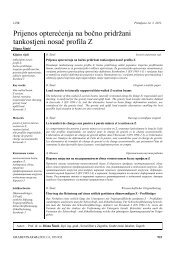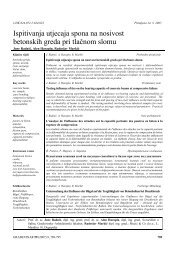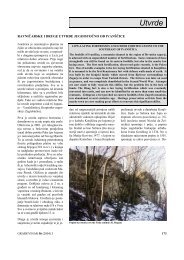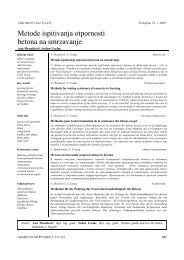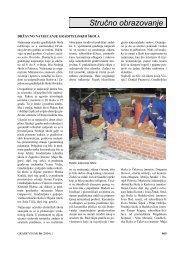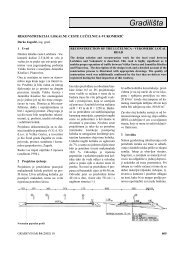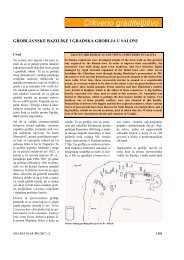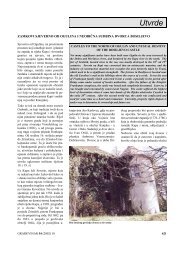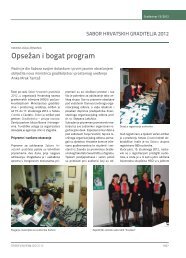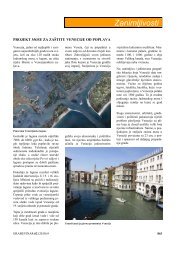Shrinkage strain of concrete - causes and types - Građevinar
Shrinkage strain of concrete - causes and types - Građevinar
Shrinkage strain of concrete - causes and types - Građevinar
Create successful ePaper yourself
Turn your PDF publications into a flip-book with our unique Google optimized e-Paper software.
<strong>Građevinar</strong> 9/2012<br />
1. Introduction<br />
During the hardening process <strong>of</strong> <strong>concrete</strong> due to the effects <strong>of</strong><br />
cement hydration <strong>and</strong> <strong>concrete</strong> drying process due to water<br />
loss, there is a reduction <strong>of</strong> the <strong>concrete</strong> volume. Concrete<br />
shrinkage is a characteristic where the <strong>concrete</strong> changes<br />
its volume over time in a way that it decreases dimensions<br />
<strong>of</strong> unloaded <strong>concrete</strong> constructions proportionally in all<br />
directions. As porous hard material, <strong>concrete</strong> starts deforming<br />
as soon as it is exposed to mechanical, thermal or hydrologic<br />
effects. Therefore, when it comes to origin <strong>of</strong> <strong>concrete</strong><br />
shrinkage we can talk about its three aspects: chemical,<br />
thermal <strong>and</strong> hydrologic processes [1].<br />
Hydrological effects, as well as thermal effects, are the result<br />
<strong>of</strong> environmental conditions changes or changes in the<br />
<strong>concrete</strong> mass. Under the environmental conditions change<br />
we consider the changes <strong>of</strong> temperature <strong>and</strong> humidity. Under<br />
the changes within the <strong>concrete</strong> mass we are considering:<br />
heat produced by cement hydration <strong>and</strong> self-desiccation [2,<br />
3], which is result <strong>of</strong> hydration continuation after <strong>concrete</strong><br />
binding, ie reduction in relative humidity due to the hydration<br />
process [2]. As a consequence, all these changes suffer<br />
from decrease in temperature <strong>and</strong> hydraulic potential <strong>of</strong><br />
construction i.e. they cause a loss <strong>of</strong> equilibrium conditions<br />
with environment. Therefore, <strong>strain</strong>s that occur are never<br />
uniform. They cause constructive effects <strong>and</strong> stresses.<br />
2. Required material properties for defining<br />
shrinkage<br />
In order to underst<strong>and</strong>, analyze <strong>and</strong> quantify all these effects<br />
on <strong>concrete</strong> shrinkage we need information regarding the<br />
following four elements:<br />
- mechanical effect <strong>of</strong> temperature changes;<br />
- thermal effect <strong>of</strong> cement hydration;<br />
- hydrological effect when it comes to hydration;<br />
- hydrological effect when it comes to climate [1].<br />
To define mechanical effect <strong>of</strong> temperature changes we<br />
need to determine the value <strong>of</strong> temperature change over<br />
time as well as the change <strong>of</strong> - <strong>concrete</strong> elasticity module<br />
<strong>and</strong> coefficient <strong>of</strong> thermal expansion (CTE). For mentioned<br />
parameters, we need to determine laws <strong>of</strong> their change over<br />
time.<br />
Concrete elasticity module is deformation <strong>of</strong> <strong>concrete</strong> under<br />
short-term load. Elasticity module develops significantly<br />
during the hardening, as well as mechanical strength, same<br />
as the compressive strength, we can consider module as<br />
monotonous continual increasing function <strong>of</strong> <strong>concrete</strong> age.<br />
Choice <strong>of</strong> aggregate has the biggest effect on elasticity<br />
module. Primarily, due to a larger share <strong>of</strong> aggregate (70 - 80<br />
%) in the whole composite mass compared to cement paste<br />
share, secondly because, in general, there is less room to<br />
change parameters that are changing module with aggregates<br />
Merima Šahinagić-Isović, Goran Markovski, Marko Ćećez<br />
than that are changing with cement mass. This second reason<br />
is closely connected to the aggregate effect on mechanical<br />
composite strength.<br />
Similar to elasticity module, coefficient <strong>of</strong> thermal expansion<br />
(CTE) depends more on aggregate than on cement paste due to<br />
volume relations. Coefficient <strong>of</strong> thermal expansion <strong>of</strong> cement<br />
paste varies from 11x10 -6 to 20x10 -6 1/°C, which depends <strong>of</strong><br />
humidity, while coefficient <strong>of</strong> thermal expansion <strong>of</strong> aggregates<br />
varies from 1x10 -6 to 14x10 -6 1/°C, which depends <strong>of</strong> type <strong>of</strong><br />
rock. Coefficient <strong>of</strong> thermal expansion values for <strong>concrete</strong> varies<br />
from 6 or 7x10 -6 1/°C for <strong>concrete</strong> with lime aggregate to 12 or<br />
13x10 -6 1/°C for <strong>concrete</strong>s with silica aggregate. With sufficient<br />
accuracy in practice, we mostly adopt value <strong>of</strong> coefficient <strong>of</strong><br />
thermal expansion for <strong>concrete</strong> from 10x10 -6 1/°C. In the other<br />
h<strong>and</strong>, opposite to E-module, coefficient <strong>of</strong> thermal expansion is<br />
practically constant after the first few hours <strong>of</strong> binding. Coefficient<br />
<strong>of</strong> thermal expansion has important part in elements which are<br />
exposed to prevented <strong>strain</strong>s conditions, in cases <strong>of</strong> massive<br />
constructions (for example, dams) or in cases <strong>of</strong> elements exposed<br />
to great changes <strong>of</strong> temperature (for example, pavements).<br />
To describe the thermal effects <strong>of</strong> cement hydration is<br />
necessary to determine the above mentioned parameters<br />
<strong>and</strong> the law that describes the development <strong>of</strong> heat during<br />
hydration. The hydration heat <strong>of</strong> cement is the amount <strong>of</strong> heat<br />
per gram <strong>of</strong> non-hydrated cement, which is released during<br />
the hydration process. It depends on chemical composition<br />
<strong>of</strong> cement (it grows with the amount <strong>of</strong> C 3 A) <strong>and</strong> grinding<br />
fineness. Hydration cement heat is an important feature<br />
in massive constructive elements (for example, dams,<br />
foundation blocks) but also when the elements are exposed<br />
to prevented ultimate <strong>strain</strong>s conditions (for example,<br />
pavements, <strong>concrete</strong> plates, composite structures), i.e. in<br />
medium thick constructions (smaller than 20 cm), when the<br />
one side is thermally isolated. With these two construction<br />
<strong>types</strong>, influence <strong>of</strong> thermal shrinkage is in superimposes<br />
with its autogenous shrinkage. Due to hydration, because<br />
<strong>of</strong> heat release, first occurs thermal expansion <strong>of</strong> <strong>concrete</strong>,<br />
which led to the cooling process <strong>of</strong> <strong>concrete</strong>, which represents<br />
the thermal shrinkage. Concrete with high hydration heat<br />
<strong>of</strong>ten have great autogenous shrinkage like in a case <strong>of</strong> high<br />
strength <strong>concrete</strong>.<br />
For hydrological effects related to hydration we need to<br />
establish the law <strong>of</strong> shrinkage development, which is<br />
determined in absence <strong>of</strong> any kind <strong>of</strong> hydrologic change with<br />
environment. These effects result in autogenous shrinkage<br />
which is consistent. If we observe it from a specific scale, the<br />
scale where <strong>concrete</strong> as granular material can be considered<br />
as homogeneous, it represents quintuple value from the<br />
biggest aggregate grain [1]. Therefore, autogenous shrinkage<br />
is internal characteristic <strong>of</strong> material <strong>and</strong> it is independent<br />
from the specimen size.<br />
For hydrological effects related to climate we need to establish<br />
the law <strong>of</strong> shrinkage development due to environmental<br />
728 GRAĐEVINAR 64 (2012) 9, 727-734



